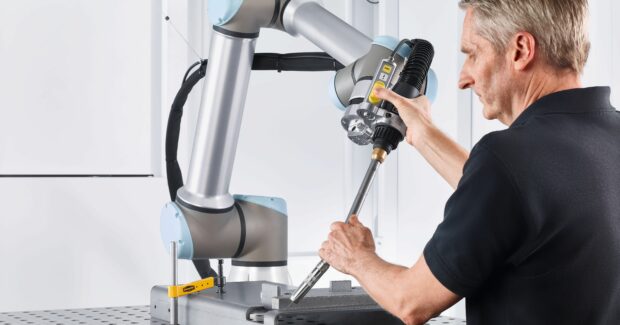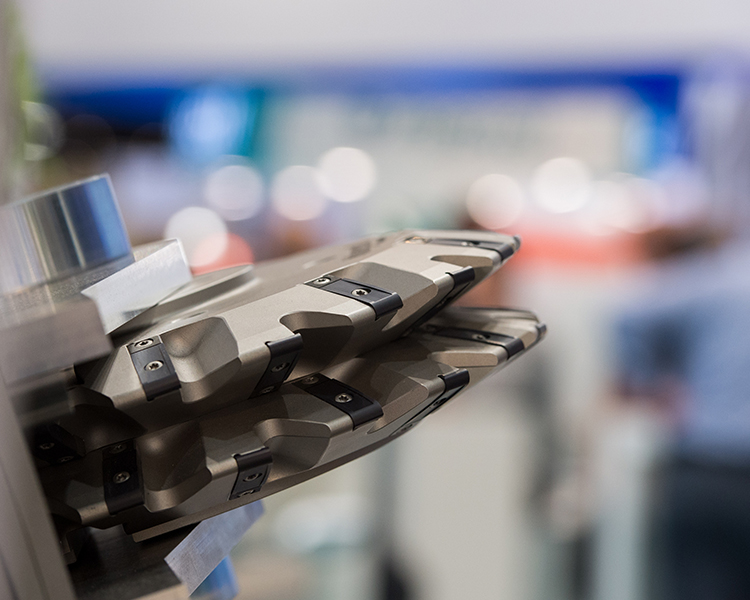Forward from The Fabricatingand Metalworking

Image: TRUMPF Group.
The future for cobots is exciting. There are developments on further improvements with usability and programming that implement artificial intelligence.
During the last few years, collaborative robots, or cobots, have made significant inroads toward creating a truly flexible and automatic workforce in the factory setting. A cobot is a robot that can work safely in a shared space with humans. While robots have a long history in manufacturing, modern collaborative robots, which can be reprogrammed and redeployed rapidly, have opened new opportunities to incorporate robotics into everyday tasks.
Most classic industrial robots are large and heavy objects, designed for mounting on a pedestal or attached to a trackway. In either case, the robot is essentially “fixed to the floor” and cannot be relocated without a great deal of work. These types of robots need complex programming software and teams of engineers to optimize their use, so the deployment of industrial robots often involves a large investment. Conventional industrial robots also require careful consideration for the safety of people in the factory space where the robot works. These considerations include implementation of light barriers, scanners, or heavy safety fencing in place to prevent injuries from robot operations. While traditional industrial robots are highly productive, their requirements can add a new layer of complexity and challenge for an industry that is striving to become more flexible and agile in manufacturing.
Cobots Enable a Flexible Factory Floor
In contrast, the growing use of cobots has opened an improved pathway to more flexible manufacturing. Cobots can be highly mobile and equipped with everything needed to be deployed on a factory floor. They can be mounted to a rolling cart, making them just as easy to move around the factory as a pallet of parts. Electrical and pneumatic connections can be made sufficiently available so that connecting the robot to utilities from any point on the factory floor is not a problem. Furthermore, because cobots are manufactured with force-limited drives, rounded edges and lightweight construction materials, the safety considerations for a cobot operating area are often much easier to accommodate than the requirements of industrial robots.
The most impressive part of the cobot technology is the programming. Because cobots are designed to be easily redeployed and taught new tasks, they are very simple to teach new motions. Cobots are usually structured around a point and click method, where you physically move the cobot through the desired task and push a button to teach it each step along the way. This simplified programming is not well suited for overly complex tasks, but for straightforward movements, a new program can be created and tested in just a few minutes. This is the secret to why cobots have made significant inroads in the factory setting. The learning curve to program and work with a cobot is very low, which makes training and implementation easy for a workforce.
Today, cobots have been implemented in a variety of cases in manufacturing. Looking at a simple and repetitive task, for example, if a hardware insertion press operator could set up a cobot with a stack of parts at one press, and then manually operate a second press, they could get through that stack of parts much faster. Even if the cobot is not as fast as the person inserting hardware, working together, the two will produce more parts per hour than either one would produce alone.
Another example of a simple and repetitive task that is ideal for cobots is feeding a stack of blanks one at a time into a deburring or finishing machine. In addition, the cobot can take the stacks of finished parts and place them in boxes. Also, a cobot loading parts into fixtures for a welder saves time and keeps the welder’s torch on longer. Or a cobot could move components from a pallet to a worktable for an assembler, so the assembler does not have to reach and bend repeatedly but can focus on assembly work instead.
Cobot Tech Offers Value in Complex Work
It might be surprising to learn that cobot technology has already shown its value in more complex work such as assisting bending operations, especially since this work is typically performed by skilled persons. Cobots have been “lightly integrated” with press brakes to simplify automated bending cells. These “cobotic bend cells” are ideally suited to longer runs of simple bending of parts. While lacking the speed and full degree of automation of larger, more completely integrated automatic bending systems, cobotic bend cells have some of their own advantages. For one thing, they can be easily moved away from the press brake if manual operation is necessary. More importantly, the programming process is relatively simple and easy for new users to learn. This means almost anyone on the shop floor can set up and deploy automation to perform simple tasks without a huge learning curve.
Even without a skilled welder, cobots can improve welding work. Cobot welding cells are becoming more advanced and thanks to simplified programming, new programs can be created and tested in just a few minutes. Combined with a programmable welding power supply, cobot welding systems can help more inexperienced welders to deliver quality welded products. Combining the repeatable motion of a cobot and simple programming of the welding power supply will lead to high quality production without the years of experience and training that is usually needed.
Just like any other tool, the key to maximizing the benefits of cobots will be learning how to best use them and getting a firm grip on the technology. We are just starting this journey with collaborative robots and the future is exciting. There are already developments on further improvements with usability and programming by implementing artificial intelligence. This will allow for more complex tasks to be assigned to these collaborative robots. There will always be the concern that with more automation, there could be less need for human labor, but as we have seen over time, the increasing use of automation creates great benefits for the workforce — improved job quality, creation of new jobs, and higher workplace safety. If you are struggling with labor, cost or quality in your manufacturing process, collaborative robots are worth exploring to tackle that issue.


































